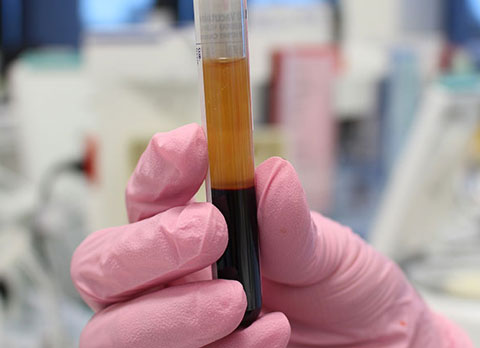In recent years a number of strategies and procedures have been implemented by the Blood Service to improve the supply of phenotyped red cells and order fulfilment for customers, measured by the percentage of orders that are delivered in full and on time (DIFOT).
Tools to improve timelines
A red cell phenotype inventory search tool enables more efficient management of phenotyped donations via the ability to quickly search work in progress (WIP) and stock inventory nationally, or by specific depot. Both fresh and cryopreserved inventory can be searched by specific blood group and phenotype. The search report also shows units that are reserved for specific patients. This report has improved efficiency by reducing administration time and gives Blood Service staff an easier way to locate red cells anywhere in the country to meet customer needs.
A red cell phenotype donor search tool has also been developed to enable better management of rare and phenotyped donors. Where sufficient notice is given for rare or difficult orders, suitable donors are routinely identified from the search and called in to donate at the appropriate time to fulfil the order. Having a process to contact these donors not only improves order fulfilment, but more regular contact has helped to improve the Blood Service’s phenotyped donor panel.
Blood Service inventory holdings are based on applicable Transfusion Guidelines (ANZSBT and NPAAC). Where orders for antigen negative blood are not consistent with ANZSBT Guidelines for Transfusion and Immunohaematology Laboratory Practice, 1st Edition, November 2016 or National Pathology Accreditation Advisory Council Requirements for Transfusion Laboratory Practice, Third Edition 2017 they will be referred to our Red Cell Reference laboratory for further discussion. The Blood Service can then work with customers on appropriate options for patient support and discuss how we can assist in finding suitable blood for these patients.
Where orders are for rare antigens or antigen combinations, customers should discuss with their regional Red Cell Reference teams and agree on appropriate lead times for order fulfilment. Finding appropriate blood for transfusion may involve sourcing suitable fresh donations from interstate or overseas, calling in particular phenotyped donors from anywhere in the country or thawing rare units from frozen inventory, which may be interstate (Table 1).
More recently, a tool has been developed to identify suitable donors for phenotyping. The tool identifies whole blood donors of suitable Rh types for phenotyping and shows country of birth, CMV history and donation count, so repeat donors can be targeted. This tool enables selection of the most suitable donors for testing so phenotyping resources are used effectively. The ability to target donors that may have specific ethnicities for particular phenotypes, for example, Polynesians for Jk(a-b-), has already proven invaluable.
National testing strategy
The inventory management process and tools are supported by a national testing strategy which simplifies and standardises the availability of phenotyped red cells for customers. The strategy includes:
• Routine extended phenotype testing performed for Fya, Fyb, Jka, Jkb, M, S and s, with preference given to the most probable genotypes R1R1, R2R2, rr and R0r. Red cells are most commonly ordered/more widely used for these blood groups, so this makes better use of phenotyping resources.
• Additional extended phenotyping is available where clinically relevant on request.
• Phenotyping targets and inventory levels have been established in each region.
The goal has been to improve equity of access to components and services for all customers, and provide clearer escalation points to Blood Service Red Cell Reference and Order Fulfilment staff where there are challenges with order fulfilment. This approach has helped to increase the number of phenotyped donors and enable maintenance of phenotypes in inventory that are immediately available to meet demand. Improvement in DIFOT has been seen as a result of these changes, despite increasing phenotyped red cell demand.


